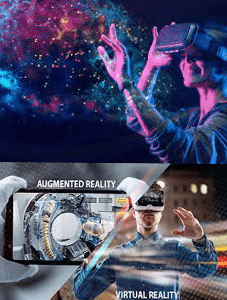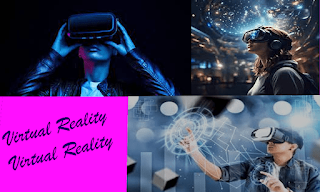Virtual Reality and Augmented Reality
Virtual reality, sometimes known as VR, gives you the impression that
you are entering a whole different world while remaining in the comfort of your
own home. It provides a wholly realistic experience that enables you to explore
virtual environments and interact with them as though they were real-world
activities.
What Is VR, Exactly?
Put on some cutting-edge goggles and, all of a sudden, you find yourself
in a stunning three-dimensional world. You can see everything around you, and
you are fully aware of your surroundings. It might be an energetic, well-lit
urban setting, a serene rural setting, or even an unearthly extraterrestrial
planet.
Users become utterly absorbed in the experience, which is a major cause
of its enormous appeal. Because of how realistic the experience is, those who
have motion sickness in real-world settings frequently experience it in virtual
worlds as well.
What Uses for VR Are There?
Despite having a lengthy history, the importance of virtual reality (VR)
increased during the COVID-19 lockdowns as individuals started to seek experiences outside of their homes. With an increase in visits to virtual
museums, art galleries, and even vacations, virtual spaces have become the preferred
travel destinations. Surprisingly, some have decided to exchange vows in these
digital spaces, complete with attire created especially for the internet.
Imagine being able to videotape your wedding in virtual reality and
afterward putting on your VR goggles to relive the memorable day as a guest.
Additionally, future generations—including your children—can experience your
wedding as if they were actually there.
VR isn't just for fun and amusement, though. It also fulfills
utilitarian functions. As a beneficial tool for worker training, virtual
reality (VR) enables people to perform risky tasks without having to take any
actual risks. Virtual reality treatment is working well in the healthcare
industry to help people with PTSD, anxiety, and other mental health issues.
Streaming services like Netflix and Prime Video are entering the VR
space, giving viewers the chance to experience cinematic adventures from the
heart of mysterious alien planets, transcending the passive observation of
traditional viewing. Additionally, the entertainment industry is quickly
embracing VR. With VR-compatible content, users can step inside movies and
immersive narratives.
VR's Effect on Business
Virtual reality (VR) has the potential to completely change how
businesses operate. It promises to change several areas, including the way
meetings and conferences are held as well as the way products are designed.
Virtual reality (VR) encourages an immersive and collaborative atmosphere in
the business world, doing away with the necessity for people to congregate in
one place.
Imagine holding a virtual meeting with people from all over the world
while giving them the impression that they are in the same physical location.
With VR, people can collaborate to envision and create product designs in a
virtual setting, doing away with the need for physical prototypes and lengthy
testing procedures. Agents in the real estate industry have previously used VR
to build realistic property simulators, allowing people to tour homes and other
properties from the comfort of their own homes.
Principal VR Applications
In summary, virtual reality (VR) has a wide range of applications in a
variety of fields.
Gaming and entertainment:
Immersive gaming experiences introduced by VR allow consumers to
interact with digital worlds in novel ways. It is a fun addition to already
popular gaming consoles like the PlayStation 5 and Xbox Series X.
Education and Training:
Virtual reality provides immersive, hands-on learning opportunities in
education and training. Pilots can rehearse flights under varied situations,
while medical students can conduct complex surgical procedures. It is widely
used in military and flying training courses.
Healthcare:
Medical applications of VR include pain management, therapy, and
rehabilitation. It facilitates the development of social and communicative
skills in people with autism, phobias, and anxiety.
Architecture and design:
By generating interactive renderings of structures, virtual reality (VR)
plays a crucial role in architecture. Even before work starts, clients and
architects may envision the finished product.
Marketing and advertising:
VR encourages engaging interactions in the world of advertising,
enabling consumers to engage with businesses in novel ways. VR is used by
brands for virtual tours and immersive product previews. Volvo, for instance,
was a pioneer in virtual reality test drives, giving customers a firsthand look
inside their most recent vehicles.
What's the difference between virtual reality and augmented reality?
Augmented reality (AR) and virtual reality (VR) are both immersive
technologies that alter our perception of the world, but they do so in distinct
ways:
Augmented reality (AR):
Integration with the real world: AR enhances the real-world environment
by superimposing digital content or information. Users can still see and
interact with their physical environment while accessing additional digital
elements.
Examples include apps like Pokemon Go, where digital creatures are
superimposed on the real world, or AR navigation apps that provide directions
by displaying arrows and information on streets.
Virtual reality (VR):
Immersive simulated environment: virtual reality creates an entirely
computer-generated virtual environment that immerses users in a digital world.
In VR, users generally wear a headset that completely blocks out the real
world, replacing it with a synthetic environment.
Examples: virtual reality is commonly used for games, simulations, and
training programs in which users can be transported into various fictional or
simulated environments.
Key differences:
Augmented reality enhances and interacts with the real world, while
virtual reality creates an entirely separate immersive virtual world. AR often
uses devices such as smartphones or smart glasses with transparent screens to
blend digital content with the real world.
Whereas VR relies on dedicated headsets that fully cover the user's
field of vision, creating an immersive virtual environment.
AR allows users to interact simultaneously with the digital and physical
worlds, often through gestures, voice commands, or touch. VR interactions are
mainly limited to the virtual environment, involving manual controllers or
haptic feedback devices.
AR is often applied in fields such as navigation, education, healthcare, and retail, where the overlay of digital information in the real world is
beneficial.
Virtual reality is popular in games, training simulations, virtual tours, and experiences requiring complete immersion in a synthetic environment.
In short, AR enriches the real world with digital information, while VR
fully immerses users in a computer-generated environment. The choice between AR
and VR depends on the specific use case and the level of immersion or
interaction required for a particular application or experience.
Technology Development in Augmented Reality
The popularity and broad use of apps and games like Pokemon Go, as well as the increased presence of AR apps in retail locations, have propelled the rise of augmented reality (AR) technology. The upcoming rollout of 5G networks is expected to be crucial in advancing the potential of cloud-based augmented reality experiences. This will be accomplished by giving faster data speeds and decreased latency to AR applications, ushering in a new era of immersive digital interactions.
With its open-source mobile augmented reality programming framework,
ARKit, Apple is at the forefront of AR development. Major corporations like
Target and Ikea have taken advantage of ARKit's potential in their flagship
augmented reality shopping apps created for iPhones and iPads. With the most
recent version, ARKit 6, users are given the ability to display augmented
reality content in spectacular 4K high-dynamic range (HDR), as well as improve
image and video capture capabilities. In addition, ARKit 6 adds a Depth API
that makes use of per-pixel depth data to give a device's camera the ability to
understand the size and shape of objects as well as produce detailed scene
geometry and topological maps of real-world spaces.
In the meantime, ARCore, the Android version of ARKit, keeps making
tremendous advancements of its own. With its new geospatial API, ARCore can
access 3D models of Google Earth and data from Street View pictures featured in
Google Maps. Similar to ARKit, ARCore has improved its Depth API and optimized
it for capabilities of extended-range depth detection.
Exciting developments in the field of augmented reality are on the
horizon, with inventions like Google's smart glasses set to transform interlingual
communication and capable of real-time audio-to-text translation. The immersive
capabilities of AR are expected to open up a wide range of new experiences and
opportunities across numerous platforms and media kinds, indicating a vibrant
future for this developing industry.
Virtual and augmented reality are fundamentally changing the way we see
and interact with the world, opening up countless opportunities for
entertainment, learning, healthcare, business, and more. These immersive
technologies have a bright future ahead of them, promising a trip that will be
dynamic and revolutionary.



